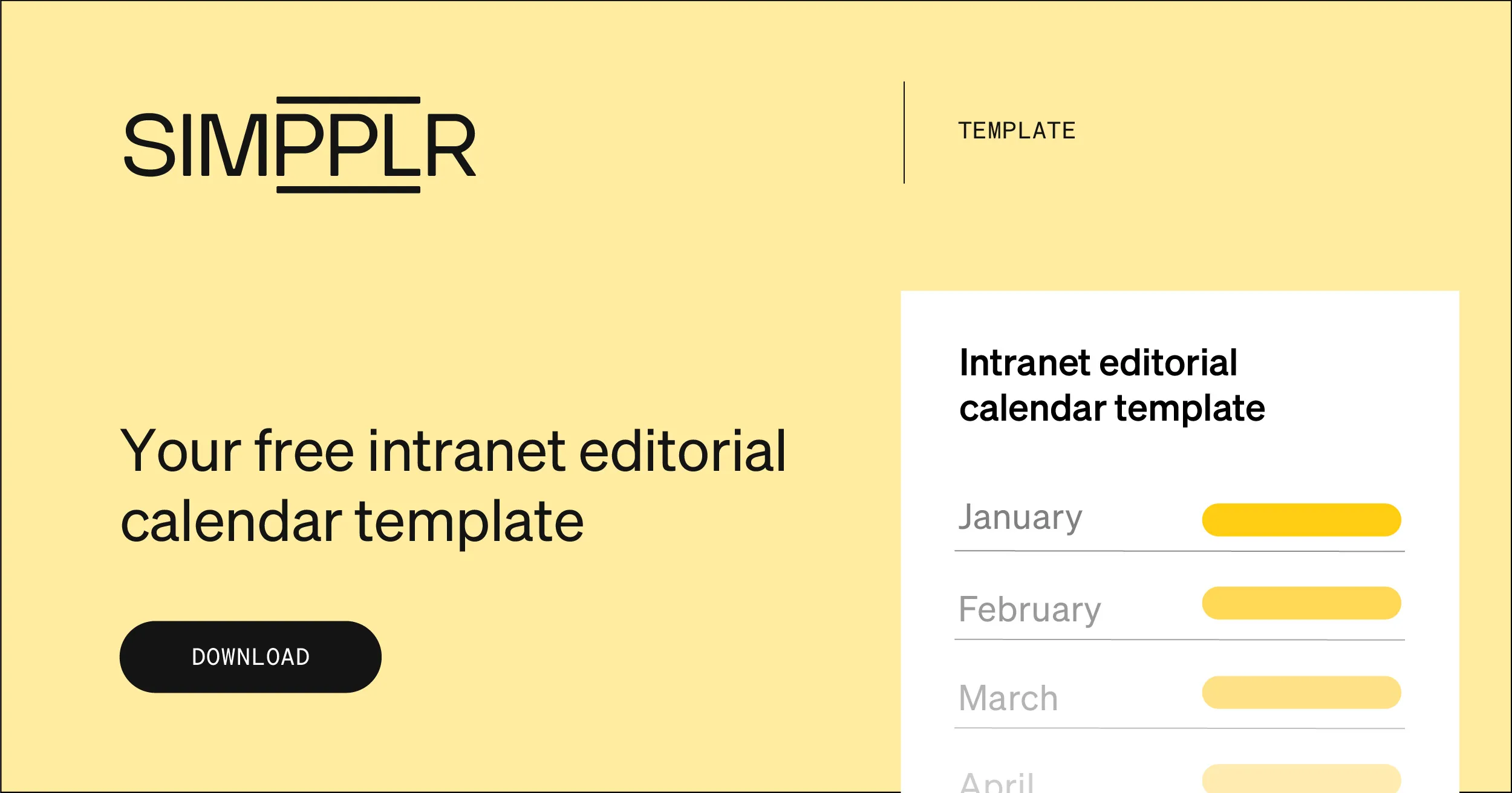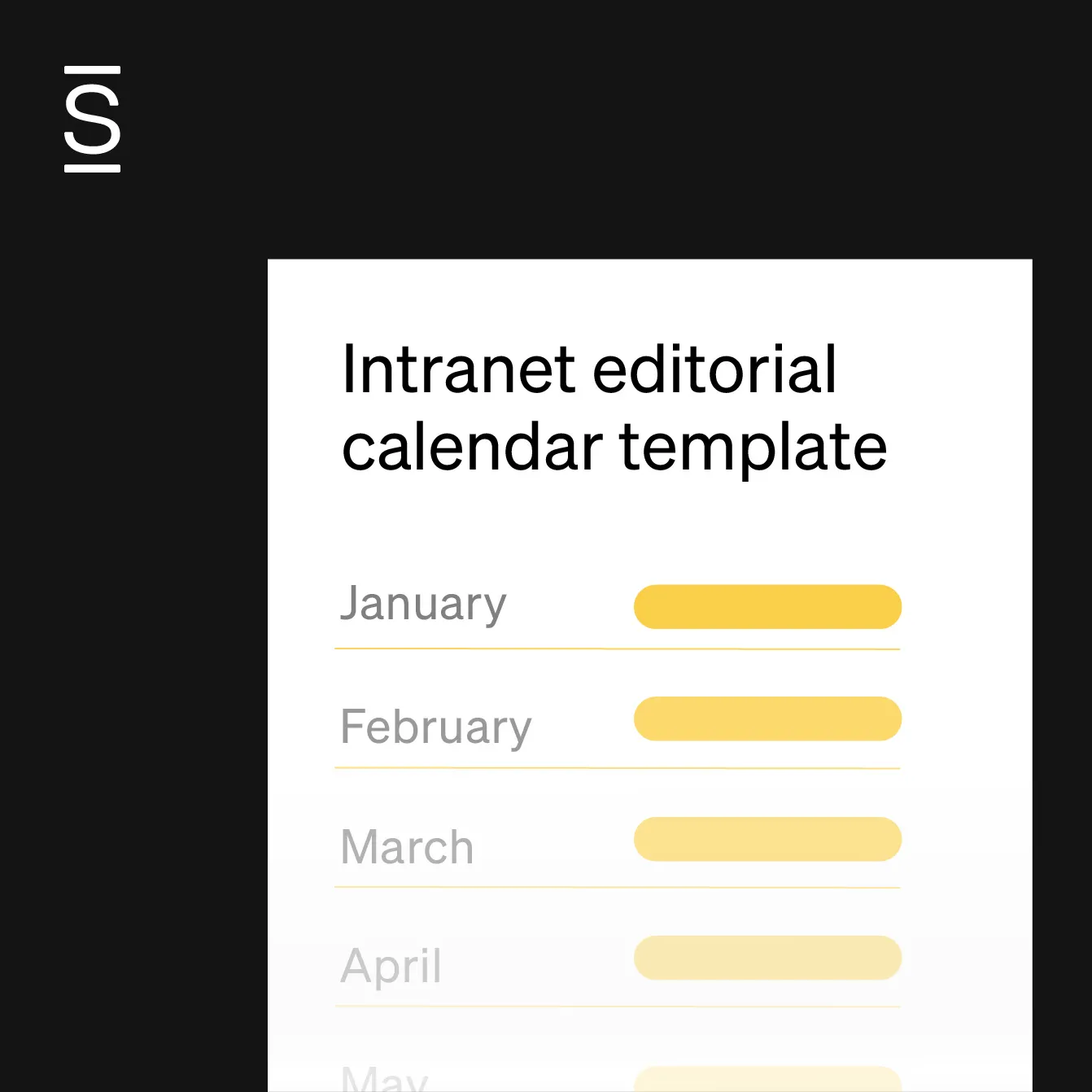Ready to make managing internal comms more efficient? To reduce the time you spend chasing deadlines, tracking content types, and keeping stakeholders informed and aligned? To streamline your workflow — from strategic content planning through multichannel publication? Learn how to create an editorial calendar. You’ll be glad you did.
An effective editorial calendar is an incredible tool for organizing and scheduling content for your intranet and other internal distribution channels. This comprehensive guide will teach you everything they need to know about how to create an editorial calendar from scratch and leverage it for maximum impact.
Table of contents: Creating an editorial calendar
Let’s dive in!
What is an editorial calendar?

An editorial calendar is a living document that outlines all the content a team plans to create and publish over a specific time frame. They usually take a monthly, quarterly or annual approach so content managers can stay ahead of their content development over set periods of time.
When it comes to using an editorial calendar for intranet content, this can be especially helpful since internal communications plans often touch many different parts of the organization.
An editorial calendar for intranet content acts as a high-level content plan. It might include:
- topics (e.g., name of blog post, video, etc.)
- formats (e.g., blog posts, videos, surveys, etc.)
- audiences (e.g., all employees, specific departments/locations/roles, etc.)
- channels (e.g., intranet homepage, email, Slack, etc.)
- publication dates and frequency (e.g., specific date, quarterly, etc.)
- owners and contributors (e.g., content drivers, subject matter experts, authors, etc.)
- publishing status (from ideation to complete)
- promotional plans (e.g., social sharing, town halls, internal newsletters, etc.)
- budget requirements (e.g., video production costs, freelance design fees, etc.)
- key performance indicators to track (e.g., post views, email click-through rate, etc.)
Editorial calendars pull double-duty as both strategic planning tools and operational task lists.
They help Internal Communication teams stay organized and on schedule. This reduces stress and increases productivity.
Strategically, editorial calendars give content managers a big-picture view to identify key themes, impactful topics and content gaps. And once you establish an overarching content plan, an editorial calendar serves as a production schedule to help streamline workflows.
Creating and maintaining an editorial calendar can set IC teams up for delivering relevant content precisely when and where employees need it — ultimately improving the employee experience.
Still not convinced? Let’s take a deeper look at the benefits of using an editorial calendar for internal communications.
Big benefits of editorial calendars for internal comms
Strategic planning pays off. According to an insightful study by Komarketing, 63% of the most successful content marketers wield a documented strategy with a structured editorial calendar.
When it comes to managing internal communications and an intranet platform, winging it with the content simply won’t cut it. Without a plan in place, it’s all too easy to end up with:
- content that’s random, disjointed and sporadic
- last-minute assignments that miss the mark
- poor alignment with company goals and initiatives
- confusing workflows and processes
- difficulty measuring success
An editorial calendar solves all these problems and more.
Streamlining workflows and increasing productivity
At its core, an editorial calendar is about workflow optimization. Staggeringly, 58% of employee time is lost to workplace coordination and poor planning.
Editorial calendars can not only increase productivity but also help recoup time lost to confusing assignments, missing deadlines and uncoordinated content requirements.
Since editorial calendars focus largely on clear deadlines set weeks (if not months) in advance, teams experience the luxury of more lead time for content publishing tasks like research, writing, video production, editing, design and expert review. This results in higher-quality content.
Everybody knows exactly what they’re responsible for and when, and any expected issues when it comes to deliverables can be flagged for management well in advance of a set due date.
They also facilitate better cross-team collaboration for content creation. With content mapped out ahead of time, content managers can easily identify relevant internal experts and contributors to tap for authorship or review.
And editorial calendars are flexible, allowing for streamlined workflows that can cater to last-minute breaking news or emerging priorities. With planned evergreen content already on the schedule, teams always have something ready to publish when they need to pivot to new priorities.
Aligning content with company culture and goals
Intranet content should reflect an organization’s culture and support strategic initiatives and objectives. Employees are internal customers — so the content they consume should connect, inspire and inform them. It should help them do their jobs and understand how their work fits into the bigger picture.
An editorial calendar can help you map content to specific business goals.
For example, if a business priority is improving employee retention, an editorial calendar could help you manage content in multiple formats around a variety of topics, such as:
- Manager best practices
- Professional development programs
- Benefits and perks
- Employee recognition
Get inspired with content ideas for 52 weeks
Keeping things organized and transparent
From topic ideas to production status, an editorial calendar tracks all of the moving parts of an intranet content plan. At any given time, team members can reference the calendar to see:
- Who is responsible for specific content publication tasks
- What topics are still in the pipeline
- When content is due or set to be published
By centralizing content development in an editorial calendar for intranet content, you also set clear expectations for every contributor — closing the window on miscommunication and excuses when it comes to keeping on schedule and even on budget.
Monitoring content performance
With everything neatly mapped out in one place, an editorial calendar makes it easy to align content to key performance indicators (KPIs) right from the start.
It’s important to show how your content drives the business outcomes that matter.
For intranet content distributed in various channels, KPIs to track might include post views, comments, likes, shares, downloads, open rate, click-through rate, sign-ups and more. These metrics ladder up to goals such as:
- Increasing the customer satisfaction score (CSAT)
- Increasing positive sentiment on strategic communications
- Improving employee survey scores (e.g., intranet content helps me find the information I need to do my job)
- Increase employee advocacy
- Improving employee retention
This is what leaders care about — and an editorial calendar that shows content KPIs gives them a high-level view into how your work helps to drive organizational success.
From there, you can refine and optimize content based on real data and analytics for continued improvement.
Related: Enhance communication with an intranet content strategy
How to create an editorial calendar for intranet content

Now that you understand the immense benefits of using an editorial calendar to help manage intranet content operations, let’s get down to exactly how to build one. Every organization’s needs and priorities will vary, but these steps will build a strong foundation.
Tip: Doing this step-by-step work upfront makes it easy to put your editorial calendar together in spreadsheet form — or, even better, to customize our free editorial calendar template for intranet content. For example, you’ll have all the information you need ready when it’s time to create drop-down menus for content types, channels, audiences, statuses and other relevant columns.
Step 1: Define content types and channels
Modern intranets support content in different formats and enable multi-channel distribution. To jumpstart your editorial calendar, make a list of all the content types/formats and distribution channels available for employees at your organization.
Mix it up with content types
Varying content formats keeps things fresh, expands audience reach, and provides more opportunities for employees to engage.
Beyond a standard blog post, unleash multimedia storytelling on the intranet with:
- Employee spotlights
- Recorded presentations
- Photo galleries
- Infographics
- Podcasts
- Short videos
- Interactive polls and quizzes
- Guides and toolkits
Make sure your editorial calendar also includes content types for specific distribution channels, like emails, social posts for employee amplification, and blurbs for internal messaging channels like Slack.
Reach employees in the right channels
In addition to content type, the intranet editorial calendar should surface all the channels through which you’ll share the content. These might include specific intranet sites/pages, email/newsletters, social media platforms, meetings, SMS, Slack/Teams, etc.
Step 2: Outline audiences
Who will you create content for? Consider all the employee audiences intranet content will target. Your list might include all employees, employees by location, employees by department, employees by job level (e.g., frontline workers, managers, executives), etc.
The best internal communications technology facilitates personalized communications experiences, so showing the target audience for each piece of content on your editorial calendar will streamline the publishing process.
Related: How to use AI to personalize and target internal communications
Step 3: Define each stage of the publishing process
One of the most practical aspects of an editorial calendar is its ability to show where each piece of content sits within the publishing process. This “status” field gives content managers a tighter rein on deadlines and helps hold contributors accountable for their deliverables. It’s also useful for leaders who want a glimpse into where content sits in the publishing pipeline.
Editorial calendars can track the progress of content from idea to completion.
For example, status fields for an internal blog post might include:
- Ideation
- Assigned
- Drafted
- Edited
- Reviewed
- Staged
- Published
- Promoted
- Complete
Your publishing process will dictate what status fields to include on your editorial calendar. You can get really granular by content type so you’ll have a long list of statuses in a drop-down menu. Or you can pare it back to show more general stages of the publishing process.
Step 4: Set a cadence
There are generally two schools of thought when it comes to the cadence of an editorial calendar: quarterly or annual.
Quarterly editorial calendars
Quarterly editorial calendars map out intranet content in three-month increments. This approach allows the flexibility to readily pivot planned topics and themes in alignment with evolving company priorities. Quarterly planning also suits organizations with more fluid business objectives in faster-moving industries.
Annual editorial calendars
Annual editorial calendars take the longest range view possible, detailing content 12 months ahead in one calendar. This option provides maximum perspective on anticipating audience needs and evergreen topic possibilities over the next year.
Annual calendars best suit brands with deeply regular communications cycles.
Choosing a quarterly or annual editorial calendar approach comes down to specific organizational dynamics and preference. The key is picking a consistent interval and sticking to it.
Regardless, an editorial calendar should sync up with important dates and milestones at your organization, such as initiative launches and events, that require content to support employee communications.
Step 5: Theme content topics
Now comes the fun part! Themes are the threads that tie content together across a set time frame. Organizing content by themes can help ensure cohesion.
Pinpoint three to five overarching themes to focus the editorial calendar around. These could be tied to:
- Company values
- Strategic priorities
- Major initiatives
- Product releases
- Industry trends
- Employee needs
Having clearly defined organization-wide themes creates a more consistent messaging thread for employees and brings focus to specific content planning.
Step 6: Brainstorm specific content ideas
The most creativity flows during the process of brainstorming all the exciting content ideas to populate an editorial calendar for intranet content.
Building out a content plan is a highly collaborative effort that flourishes with cross-functional insight.
Be sure to involve key stakeholders from other teams, such as HR, IT, Product and Corporate Communications.
Workshop content ideas using prompts like:
- What topics would help employees do their jobs better?
- What big initiatives are on the roadmap?
- What do we want employees talking about at the watercooler?
- Where are there current knowledge or awareness gaps?
- What types of content do certain groups consume most?
- What messaging deserves amplification from leadership?
To guide brainstorming, map content ideas back to themes and consider how you can communicate the same message in different formats to accommodate varying learning styles and increase engagement.
Leave the session with a prioritized list that meets workforce interests while aligning with company imperatives.
Related: 10 must-have employee intranet content types
Step 7: Assign owners and deadlines
An editorial calendar for intranet content should not become a to-do list for the IC team to handle. Content development is a shared responsibility spanning many internal experts in an organization. With priority content ideas narrowed down, loop associated owners into the mix.
First, identify who’s on point to manage each piece of content. Then assign owners for each stage of the publishing process — like writing, editing, reviewing, creating images, publishing on the intranet, and promoting in other distribution channels. Keep in mind that a tool designed specifically for project management — like Monday.com or Asana — is a better option for actually working content through the process. The editorial calendar is the map.
When assigning deadlines for each publishing task, be sure to to include enough time for everyone to do their part and incorporate buffer time to account for obstacles like sick time and vacations.
Step 8: Track key performance indicators
It’s not enough to create and distribute great content. To fuel continual optimization, content managers must actively monitor how each piece performs.
Gather the KPIs that matter most for measuring content impact from both a quantitative and qualitative lens and use these to determine whether the developed content resonates effectively with the target audiences. Remember these metrics should track back to overarching content themes and company objectives.
Tip: Include the target KPIs for each piece of content in the editorial calendar, and link the KPIs to a spreadsheet or whatever system you use to track content performance.
Related: The ROI of internal communications
Step 9: Refine and repeat
While they establish hard deadlines from the start, editorial calendars are living, evolving documents. Build in time to formally revisit the initial content strategy by analyzing performance, evolving themes, brainstorming new ideas, and adjusting course as needed.
Refinement is key to keeping content perpetually aligned with audience needs and shifting organizational priorities.
Editorial calendar tools
You don’t need to build an editorial calendar from scratch. There are lots of calendar-building options available — from spreadsheet-based templates that you can customize to project management software and calendar tools integrated into content workflow management platforms. Here are some favorites:
- Project management tools like Airtable, Asana, Trello, Basecamp and ClickUp offer features such as tagging, annotation and different views (e.g., calendar and grid) so you can track intranet content from start to finish. However, these project management solutions aren’t built for editorial content management so expect to spend time adapting them for your use.
- Content management software like Narrato, Kapost and CoSchedule is designed for managing content and often integrates easily with enterprise software like content management systems (e.g., WordPress). The downside? This dedicated software tends to be pricey, so it might not be the best option for IC teams at smaller organizations.
Get your free intranet editorial calendar template
Streamline intranet content planning and unlock team superpowers with Simpplr’s all-in-one editorial calendar template for intranet content. It’s designed for IC teams ready to play to win, so be sure to download your free template today!

Frequently asked questions
What types of content can you manage with an editorial calendar?
An editorial calendar can help you manage intranet content, blog content, social media content, podcasts, webinars, videos and more. These are go-to tools for internal communicators and marketing teams.
Why do I need an intranet editorial calendar?
Plain and simple — strategic planning leads to more effective internal communications. An editorial calendar clarifies fuzzy workflows, provides greater visibility into the intranet content pipeline, helps ensure higher quality content, and makes monitoring metrics easier.
How do editorial calendars differ from content calendars?
You’ll often hear these terms used interchangeably, but there are subtle differences. Editorial calendars typically take a higher-level strategic view, providing a monthly, quarterly or annual look at planned content. Content calendars focus on the specifics for each piece of content. Many internal communicators teams use one calendar to accomplish both goals.
How Simpplr can help
Armed with an intranet editorial calendar, you’re poised to plan and publish internal comms that inform, engage and inspire employees. Simpplr can help.
Our AI-powered employee experience platform goes beyond just an intranet. It helps you deliver beautiful, highly personalized, and targeted employee communications without any technical or design help.
Simpplr is the only platform that unifies employee engagement, enablement and services, leveraging state-of-the-art AI models to deliver a seamless, cohesive and personalized employee experience. Request a demo to learn more!

















